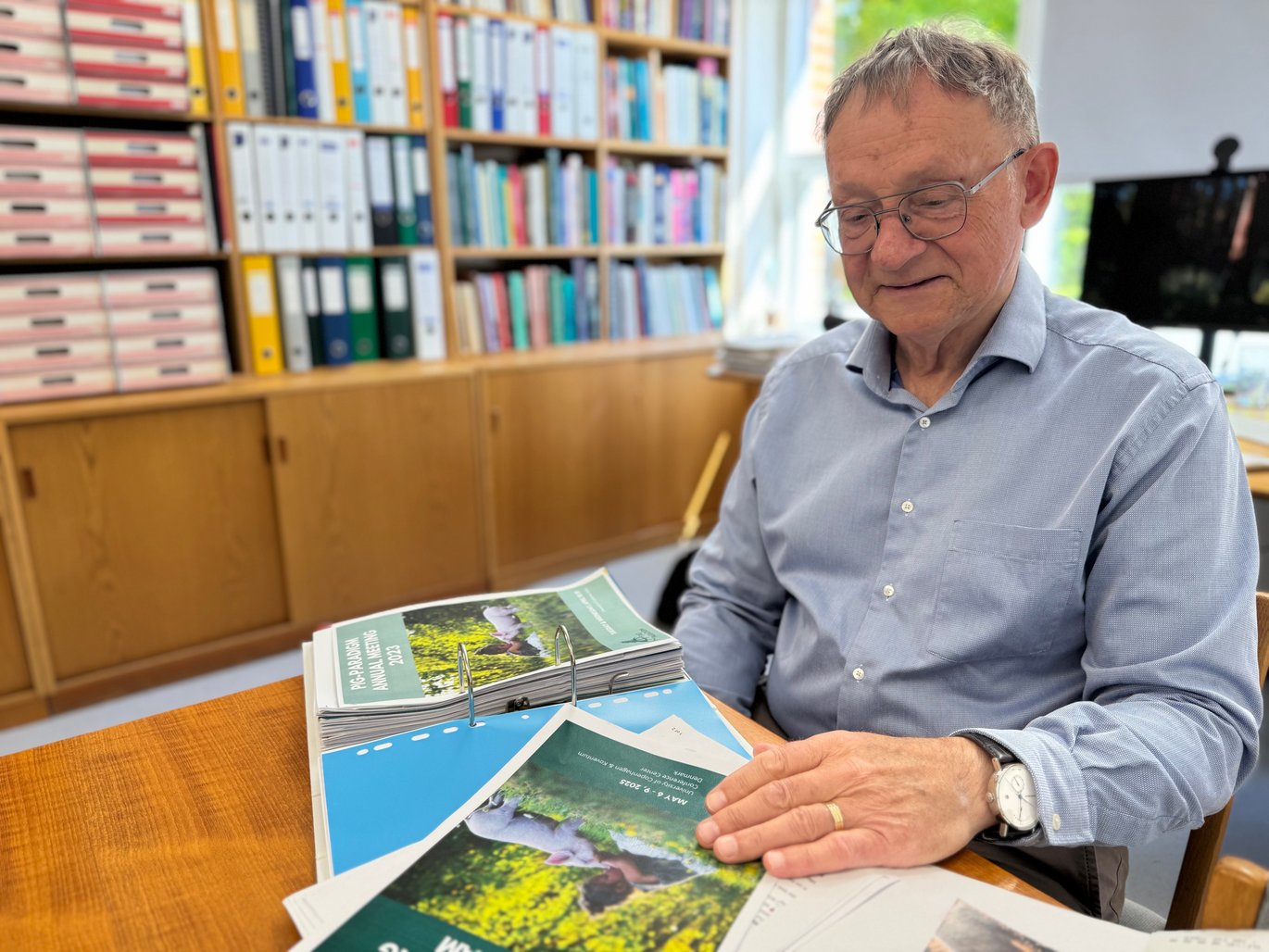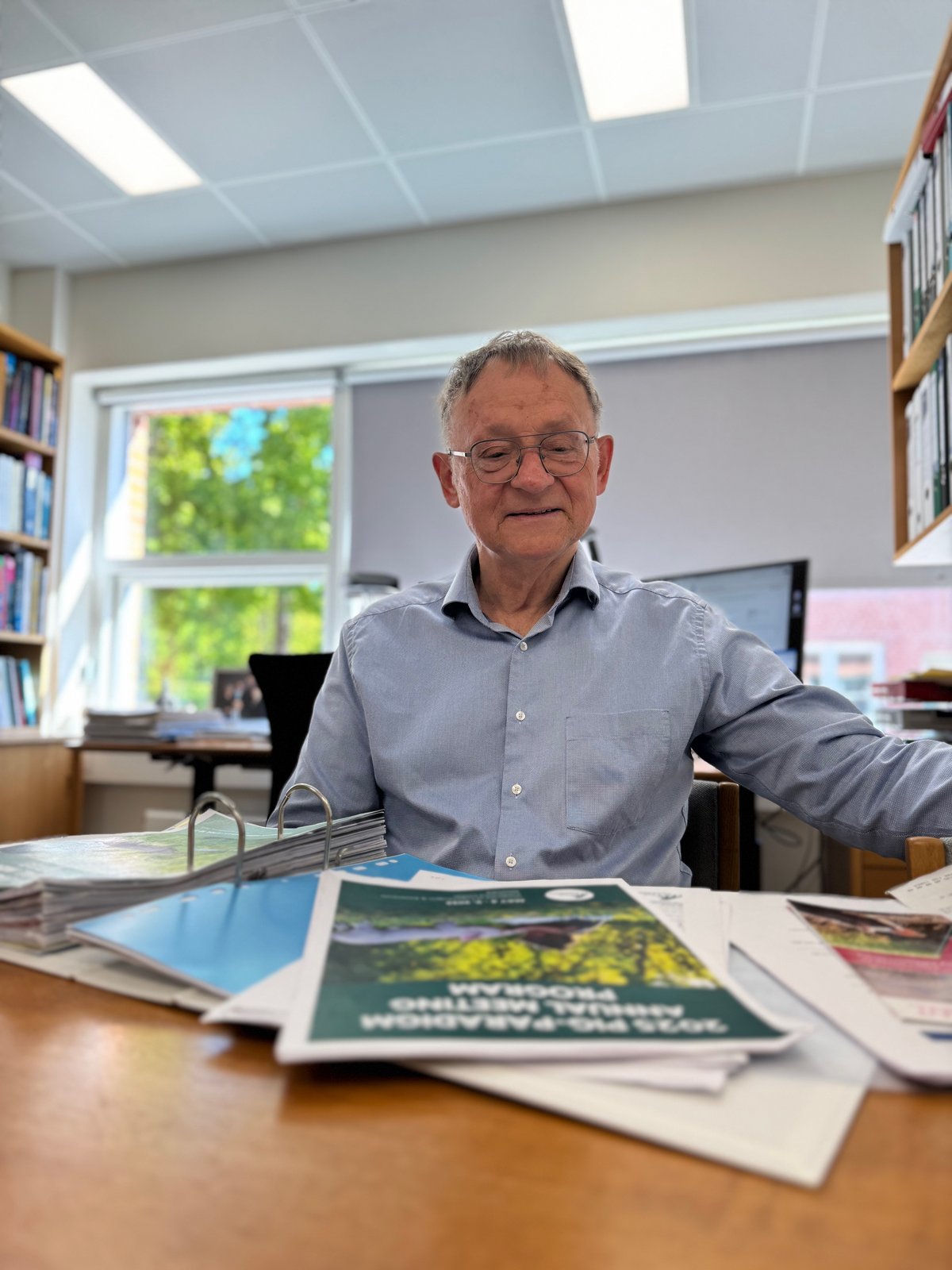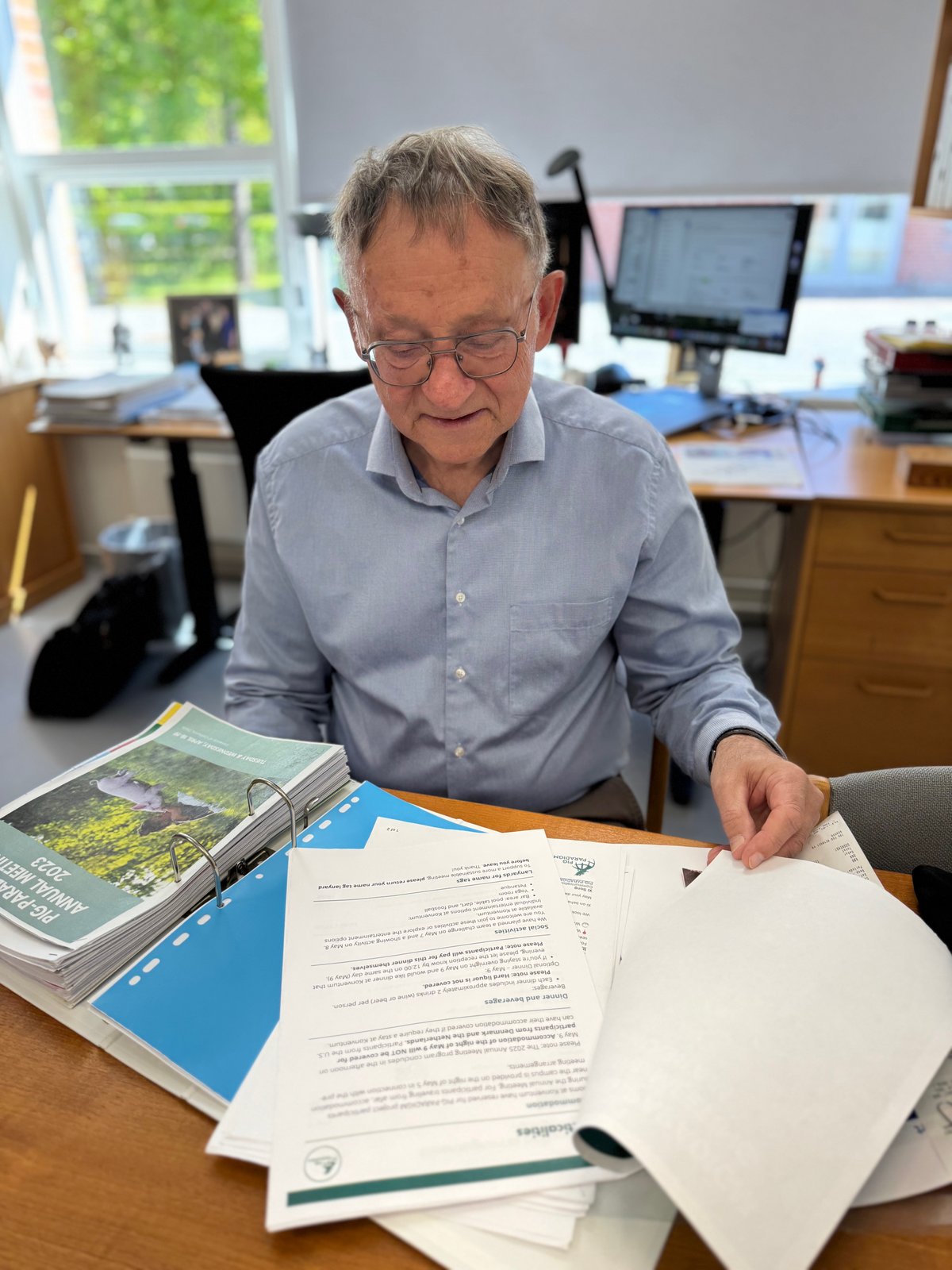A Healthy Gut: A Key Piece in the Green Transition
From Research to Revolution: How Gut Health Shapes Sustainability. The story behind the PIG PARADIGM project as seen through the lens of Professor Knud Erik Bach Knudsen

It's Thursday morning, approximately 34 months- or 2 years and 9 months -since the ambitious PIG-PARADIGM project was officially launched. Professor Knud Erik Bach Knudsen arrives prepared, carrying two large binders under his arms before settling at his desk at Aarhus University, AU Viborg.
Knud Erik has been involved from the very beginning along with a handful of work colleagues. He shares his perspective on how this remarkable, large-scale research project became much more than the starting point of an international collaboration. It has also emerged as a significant contributor to the broader green transition process.
His office is neatly packed with white ring binders and case files—a testament to a long career dedicated to research.
How did the PIG-PARADIGM project come to life?
In the spring of 2018, a request landed at Aarhus University, Research Centre Foulum from the enzyme company Novozymes, Knud Erik recalls.
"I've reviewed everything. It has been some years now, and it's easy to forget dates," Knud Erik says with a smile. Knud Erik has been a regular presence in the department since 1986.
Who is Knud Erik Bach Knudsen?
Knud Erik Bach Knudsen spent over 30 years working on the analytical, nutritional, and health aspects of carbohydrates in both feed and food.
Knud Eric Bach Knudsen has helped develop modern techniques to fully analyze the carbohydrate content in these products. He has also done a lot of basic nutritional studies on pigs and sows, focusing on how they digest and absorb carbohydrates.
This basic knowledge has been used in dietary studies aimed at preventing digestive issues in piglets, controlling parasites in growing pigs, and improving satiety and behavior in sows.
Additionally, he has investigated the nutritional and health benefits of phytochemicals, especially plant lignans, in monogastric species including humans.
"Novozymes wanted to know if we could address some issues surrounding the topic of 'a healthy gut in pigs,'" Knud Erik reflects. They recognized significant opportunities for a larger project in this area, with the potential, over time, to develop biomarkers that could identify a healthy gut.
Novozymes had also been in touch with institutions such as the University of Copenhagen, Knud Erik recalls, while double-checking dates in his calendar for accuracy.
Moreover, it became evident that the Novo Nordisk Foundation was shifting its focus, expanding to support more general-purpose initiatives beyond its previous focus on diabetes and obesity research.
Why are healthy guts in pigs important today?
Antibiotic resistance (AMR) in animals, including pigs, is one of the most urgent challenges of our time—not only for public health but also for the environment and the green transition. When bacteria become resistant to antibiotics, it can lead to serious consequences for both animal welfare and human health, as treatments for infections become ineffective, explains Knud Erik.
This concern has driven institutions like Aarhus University to focus extensively over the years on discovering new approaches to antibiotic use and prevention, Knud Erik adds.
"Reducing dependence on antibiotics leads to better animal welfare and more natural production methods, which in turn reduces environmental impact. A healthy livestock population using low levels of antibiotics ensures sustainable production," says Knud Erik.
Knud Erik vividly recalls the initial meeting with two representatives from Novozymes alongside then-Department Head Klaus Lønne and current Department Head Charlotte Lauridsen. This was where the first project ideas were exchanged.
"We created a two-page project -description that had to be sent to the Novo Nordisk Foundation (NNF)," he recounts.
At that time our project was entitled “A global challenge to reduce antibiotic consumption via dietary interventions: Establishment of basic research in gut health of piglets with the aim to prevent diarrhea”.

Funding applications were to be submitted to NNF for a workshop later that fall. Before that, they set out to identify international academic partners. The project wasn’t intended to be a purely Danish consortium but rather a broader collaboration with foreign entities.
"If one is to tackle a highly complex issue, international collaborations are absolutely essential. Ambitions were high for the project's scope," says Knud Erik.
A principal investigator project also needed to be appointed, and the choice fell on Charlotte Lauridsen.
"The next step was to identify relevant international researchers to form a dream-team, and we then invited key scientists at Wageningen University and the University of California, Davis. In January 2019, Chalotte Lauridsen sent the first version of a workshop proposal.
Corona delays the project
Chalotte and the team were subsequently invited to develop in collaboration with the Novo Nordisk Foundation (NNF) who facilitated the further development of the program but, as Knud Erik recalls, the workshop faced some delays. Initially postponed to August 2020, it was further delayed when the COVID-19 pandemic struck, bringing most activities to a halt, Knud Erik explains.
“The infection pressure just kept rising and rising, so we couldn’t meet face-to- face as originally planned,” he notes.
Throughout the fall and winter of that year, no in-person meetings took place. Charlotte had several meetings with Merete Fredholm and NNF representatives on how to progress with the workshop arrangement. To prepare the participants, some pre-symposia were organized, such as an engaging online keynote presentation by Peter Sandøe from the University of Copenhagen, focusing on the use of antibiotics in pig production.
“In that way, we kept the pot simmering,” Knud Erik smiles.
Eventually, a three-day virtual workshop was held in January 2021, bringing together researchers from Aarhus, Copenhagen, the Netherlands, and California. Many intriguing challenges were discussed during these sessions.
The full project proposal, built upon the outcome of the online workshop, was then put together by the project coordinator, Charlotte Lauridsen, and key people from University of Copenhagen, Wageningen University and University of California, Davis and submitted to the Novo Nordisk Foundation.
“The project coordinator submitted the final application on October 14, 2021,” he recalls, glancing at his calendar to confirm the date.
The funding approval, which involved evaluations by international experts, came at the end of 2021. Meanwhile, further refinements were continuously incorporated into the project, Knud Erik explains. Securing the grant agreement between the participating universities also took some time.
The kickoff meeting in June 2022 marked the official start of the PIG-PARADIGM project.
The following period proved to be eventful, as numerous PhD candidates and postdocs were to be recruited for the project, which was structured around four pillars. Knud Erik elaborates on these pillars:
- The Host Pillar – the pig itself, which forms the central focus.
- The Microbiome Pillar – a critical aspect, particularly concerning diarrhea, as heavy antibiotic use is often linked to the post-weaning period when digestive issues arise.
- The Nutrition Pillar – representing feed and supplements. “Most activities here at AU Viborg fall under this pillar,” Knud Erik points out.
- The Data Integration Pillar – designed to tie all the project’s data together across disciplines and institutions.
What is PIG-PARADIGM?
The PIG-PARADIGM project was initiated to tackle the growing issue of antimicrobial resistance (AMR) in pig farming. The project aims to reduce the need for antibiotics by understanding the complex interactions between the pig host, its microbiome, and nutrition.
The project was launched in 2022 with funding of DKK 150 million (€20.1 million) from the Novo Nordisk Foundation. Researchers from universities in Denmark, the United States, and the Netherlands have come together to explore how dietary environmental and host factors can improve intestinal resilience in piglets.
By enhancing gut health, the project seeks to prevent bacterial infections and reduce the spread of AMR. The collaboration across institutions and borders brings together diverse expertise and technologies to find innovative solutions to AMR.
The project's findings are expected to contribute significantly to the long-term effectiveness of antibiotic therapy in both human and animal health.
Midterm status
Knud Erik Bach Knudsen takes stock of the PIG-PARADIGM project, although it’s understandably a challenge to evaluate a project still in progress and set to run well into 2027.
“The exciting part of the project is that it’s the first time we’ve ever had such a large-scale project focused on a specific topic. We’re still in the middle of this extensive project phase, but at AU Viborg- Research Center Foulum, most animal experiments have been completed at this point,” he shares.
“Now, we’re moving on to the analysis and writing stage, where all the pieces come together—and we’re very eager to see the results.”
One of the significant challenges during the project has been the logistics of hiring many PhD students and postdocs.
“We also had an incredible number of pig experiments running simultaneously, which was a bit of an organizational challenge,” says Knud Erik matter-of-factly, quickly adding that it proved to be an excellent learning experience.
Knud Erik is highly optimistic about the results and recommendations that will emerge from the project. However, he emphasizes that there is always a practical-economic context, where the costs of modern pig production play a role. He adds, though, that reducing the use of antibiotics is in everyone’s interest.
Why is reducing antibiotic use so important?
“Pigs are generally susceptible to infectious diseases in the gut, particularly during the weaning phase, which is why antibiotics are frequently used in pig production. But the problem arises when antibiotics lose their effectiveness—making outbreaks among livestock much harder to control,” Knud Erik explains.
He continues, “When bacteria become resistant to antibiotics, we encounter what’s known as AMR (antimicrobial resistance), which makes treating infections significantly more difficult. Unfortunately, overusing antibiotics can lead to the development of resistant bacteria, which can be transferred to humans through the food chain or direct contact. So the ultimate goal of PIG-PARADIGM is to keep antibiotics effective 30 years from now for both pigs and human.
Knud Erik also highlights the environmental perspective:
“Reducing antibiotic use means fewer chemical compounds are released into nature, which undoubtedly benefits biodiversity and the environment. It can even have a positive impact on the climate by lowering greenhouse gas emissions from intensive agriculture.”
He stresses the global dimension: “On a global scale, AMR threatens public health by diminishing the effectiveness of critical treatments. Philosophically, the fight against AMR reflects our responsibility as stewards of nature.
In conclusion, Knud Erik states:
“By reducing AMR, we can promote a more holistic and respectful approach to nature, where we work with its natural processes rather than against them. The fight against AMR is part of a broader movement toward a more responsible and sustainable future—one that safeguards both our health and the planet’s”.

| Additional information | |
We strive to ensure that all our articles live up to the Danish universities' principles for good research communication (scroll down to find the English version on the web-site). Because of this the article is supplemented with the following information: | |
| Project Title | PIG-PARADIGM |
| External funding | NOVO NORDISK FOUNDATION |
| Collaborators | Wageningen University, University of California, Davis, University of Copenhagen, Aarhus University. |
| Read more | https://projects.au.dk/pig-paradigm |
| Contact information | Knud-Erik Bach Knudsen: knuderik.bachknudsen@anivet.au.dk Charlotte Lauridsen: charlotte.lauridsen@anivet.au.dk |
